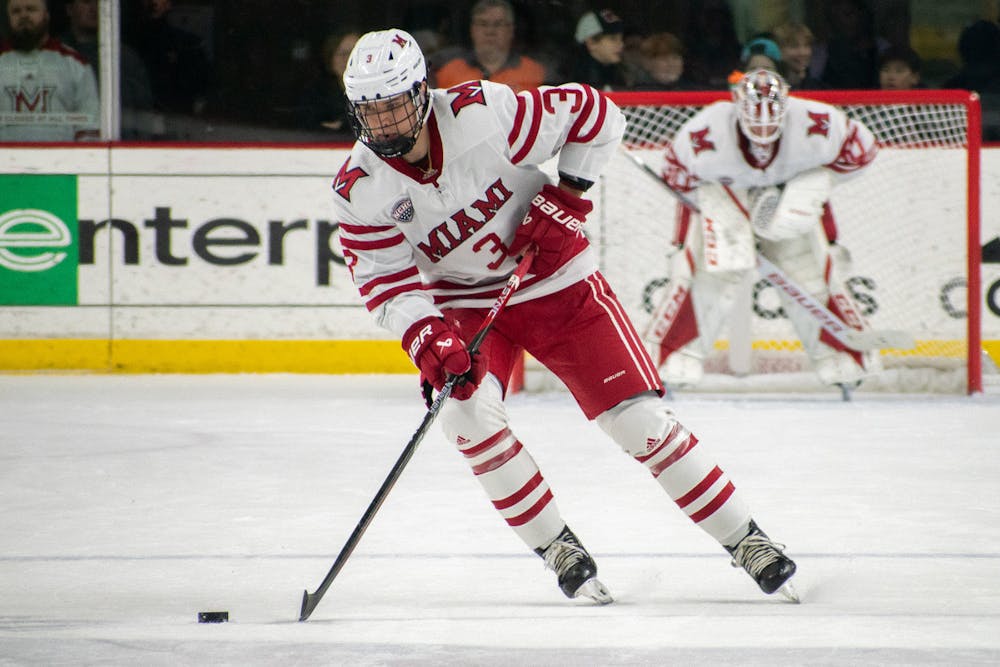Over recent years, the Miami University hockey program has struggled to find success. This season has been no exception, with the squad currently posting a 7-20-3 overall record and a measly 1-17-2 record in conference play.
The RedHawks hope to revitalize their program through some strong recruiting classes, which makes attracting top-end talent to Miami a high priority.
So, why do hockey players decide to come to Miami University?
For associate head coach Barry Schutte, players choose Miami for the social and educational opportunities.
“Small college town, intimate, engaged experience… a social experience that’s in a fun, safe environment that you can be proud of, and an academic experience that’s going to challenge you and push you outside your comfort zone but yet not overwhelm you,” Schutte said. “Those two heads I think are true for all Miami students, and those are still true for the student athlete.”
This idea is true for Bruno Bruveris, a first-year goaltender from Latvia, and Max Dukovac, a sophomore forward from Illinois.
“The first thing that stood out to me was the campus and the services that the school provides,” Bruveris said. “The business school of course was one aspect of it, and the second one probably would be the history of Miami hockey.”
“I had been on a few tours before and I’ve seen other college campuses, and this one is by far I think the most beautiful one that I’ve seen,” Dukovac added.
The recruitment process for NCAA Division I hockey typically begins around a player’s 15U year, as coaches are not allowed to contact players until Jan. 1 of their sophomore year of high school.
Schutte said the scope of the recruitment process has changed dramatically in recent years with the emergence of widespread video at the junior hockey level. Rather than focusing recruiting efforts in nearby areas, coaches can now efficiently evaluate players from their office.
“Let’s say we need a left-shot, offensive defenseman, and let’s say we narrow that list down to five guys,” Schutte said. “Well, we can really go back and watch every shift that those individuals play every weekend from our offices and start to narrow it down, and then maybe we end up with our top two from the top five.”
Video has also made it easier for the coaching staff to evaluate international prospects, who have become an increasingly significant focus of Miami’s recruiting efforts over recent years. This year’s roster features 10 international students, including four Swedish players, three Latvians, two Canadians and a Slovakian.
Enjoy what you're reading?
Signup for our newsletter
The program’s transition toward international players has been born out of a shift in priorities among North American recruits. While opportunities for playing time have historically played a much bigger role in commitment decisions, modern North American players are more focused on overall team success. With Miami’s recent struggles, it has been difficult to attract these recruits.
“We feel like we’ve been able to access a higher-level player on some level with some of the international kids because they’re looking for similar things that we’re looking for,” Schutte said. “A place where people matter, there are relationships and trust, all the facilities and the holistic approach of academics, athletics, social … that matters to them.”
The explosion of the transfer portal in college athletics has also forced the RedHawks to adapt.
The team saw a mass exodus through the transfer portal at the conclusion of last season, losing eight players, including standouts Red Savage and Ludvig Persson. This forced the coaching staff to dip into the portal to replenish their numbers, but they want to avoid making that a top priority in the long run.
“Some [programs] have chosen to continue to try and do it the traditional way with the four-year guy,” Schutte said. “That’s ideally what we’ve tried. With our 10 sophomores, we’re hoping they’re four-year guys.”
The RedHawks do have a promising recruiting class coming in next season, with most players coming from the United States Hockey League (USHL), the top junior league in the U.S., as well as the top Swedish junior league.
The coaching staff places its faith in the current roster and returning players, and they see the incoming recruiting class as a means of adding to their established talent.
“We need to improve our skill, and that’s been a focus,” Schutte said. “We need to improve our overall hockey IQ. Now, we feel like some of our talent rests within our sophomore class, which hopefully will all be returning, and then we wanted to add some more NCHC-type skill and talent to the lineup.”
Miami’s current squad is nearing the end of its season, playing its final home series of the season against the University of Nebraska Omaha on Mar. 1 and 2 at Goggin Ice Center.




